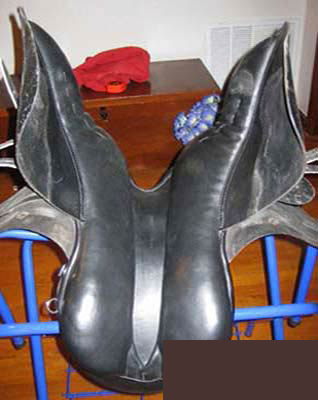This photo shows the part of an english riding saddle known as the “billets”. The billets are three straps underneath the top flap, on each side of the english saddle. The billets are the straps which attach to the girth to anchor the saddle on the horse’s back. The billet straps are securely stitched to the tree (the hard “skeleton” of the saddle) so once a girth is buckled to the billets, the structure of the english saddle is secured in place and prevents the saddle from slipping (if the girth is sufficiently tightened).
Billet Strap Safety
Billet straps are the most vunerable part of the girthing mechanism so it is important to inspect your english saddle’s billet straps regularly. If the english billet straps are stiff and brittle, a sharp intake of the horse breath or sudden expansion of the chest (like during jumping or descending into a river crossing) can cause the billet straps to break and the saddle to come off! This is a major safety hazard seen too frquently, especially with cheaper english saddles (which use lower quality leather for billet straps) and poorly cared for tack. Check your billet straps regularly for signs of cracking, dryness, of stiffness. Generally billet straps should not be oiled during regular tack cleaning, as oil can cause them to stretch, but a light coat of conditioner should be applied to dry, stiff billet straps.
Why are there 2 buckles on a girth, but 3 billet straps?
Even though there are three billet straps on most english saddles, the english girth is designed only to attach to two of them. This is in case one billet strap breaks in the field or your horse is not comformationally comfortable with the girth where it naturally sits. Some horses, and some saddles, require that the girth be buckled to the front two billet straps, or the back two, but for the vast majority of horses, the girth should be buckled to the outer billets, as this provides the most stability for the saddle. If your horse is prone to girth galls or sores, experiment with attaching your english girth to the front two billets, or the back two billet straps.


Leave a Reply